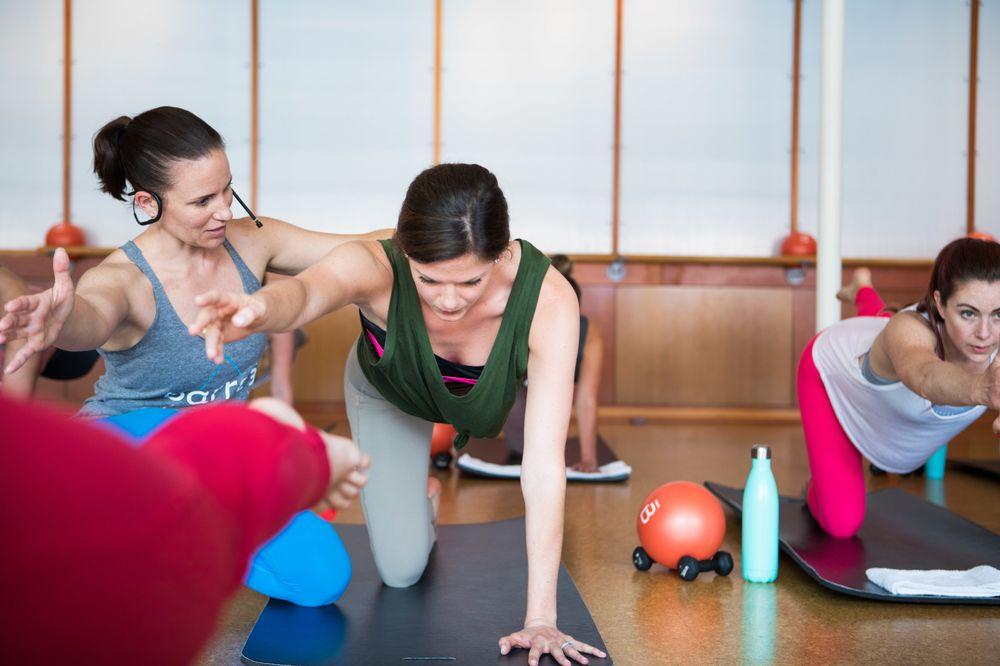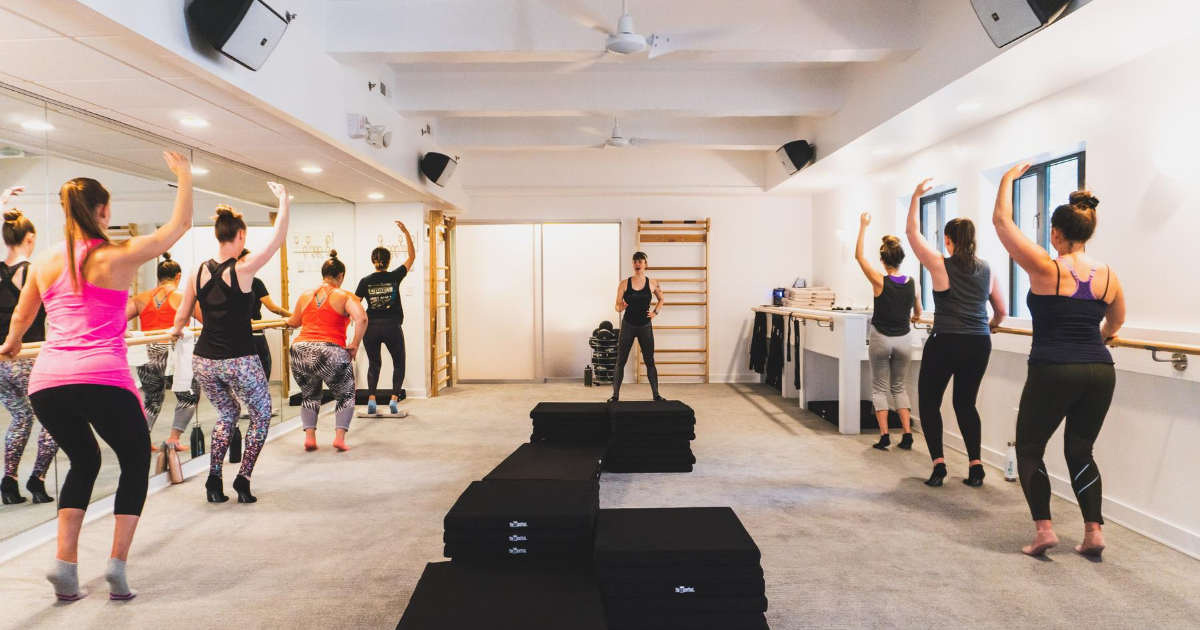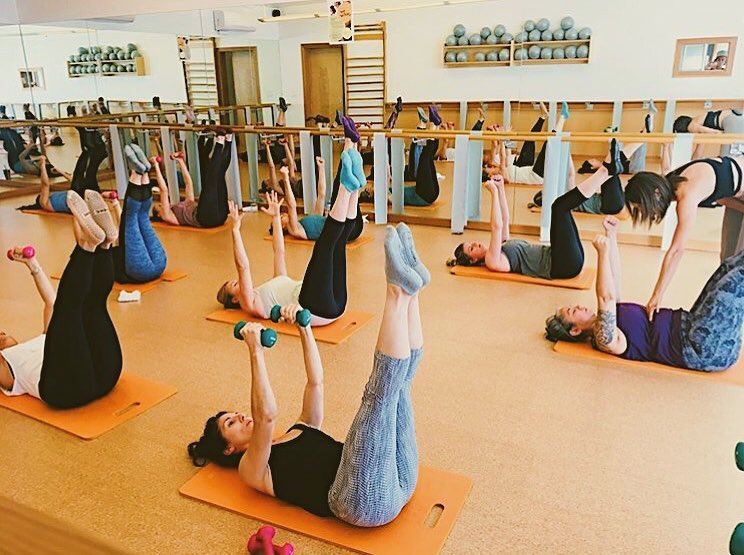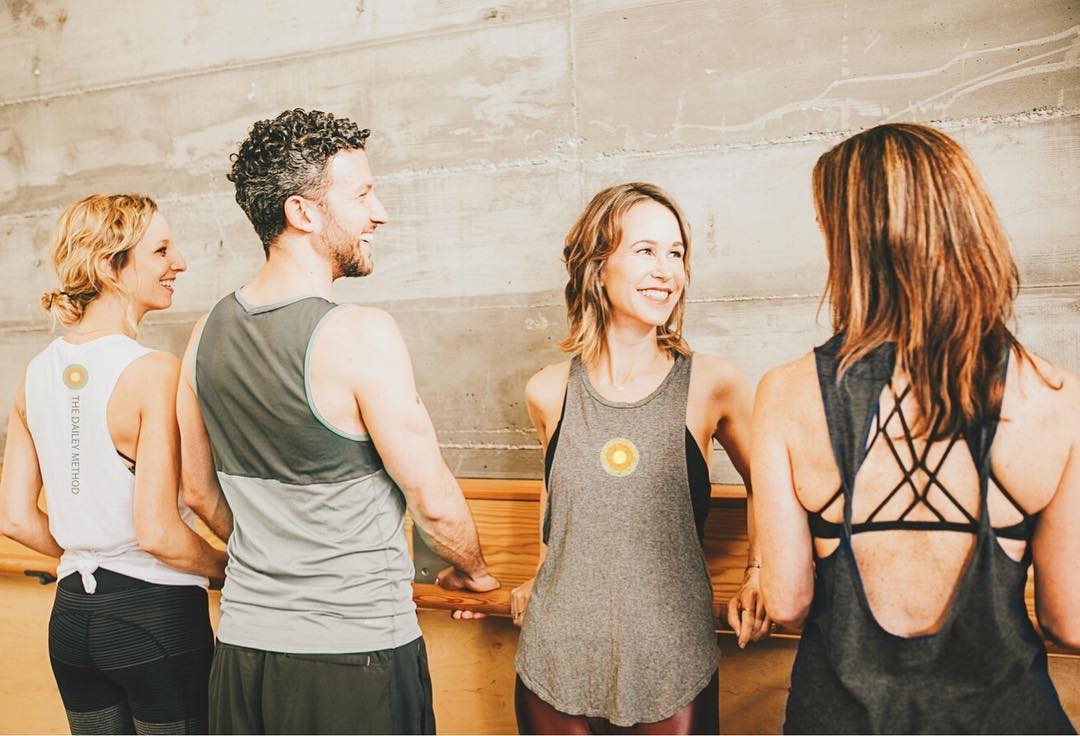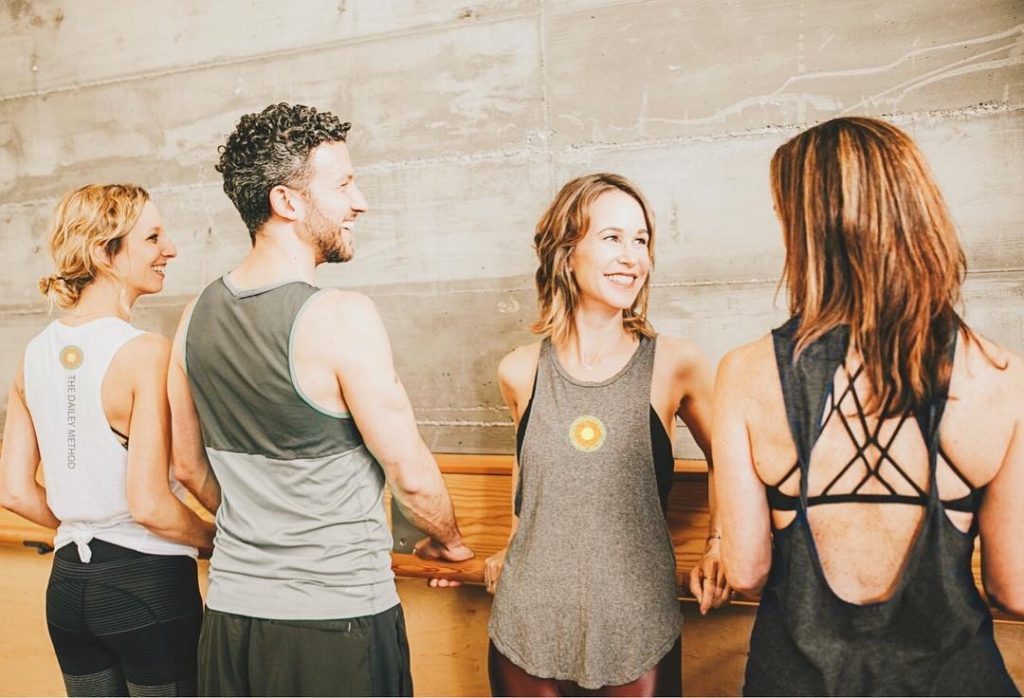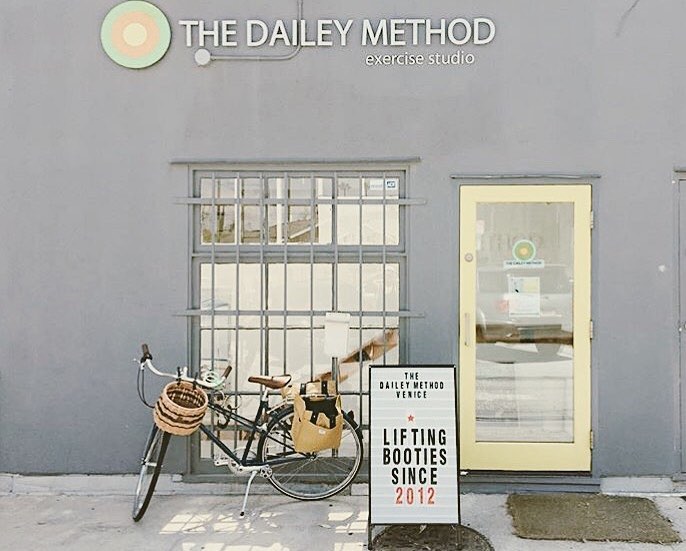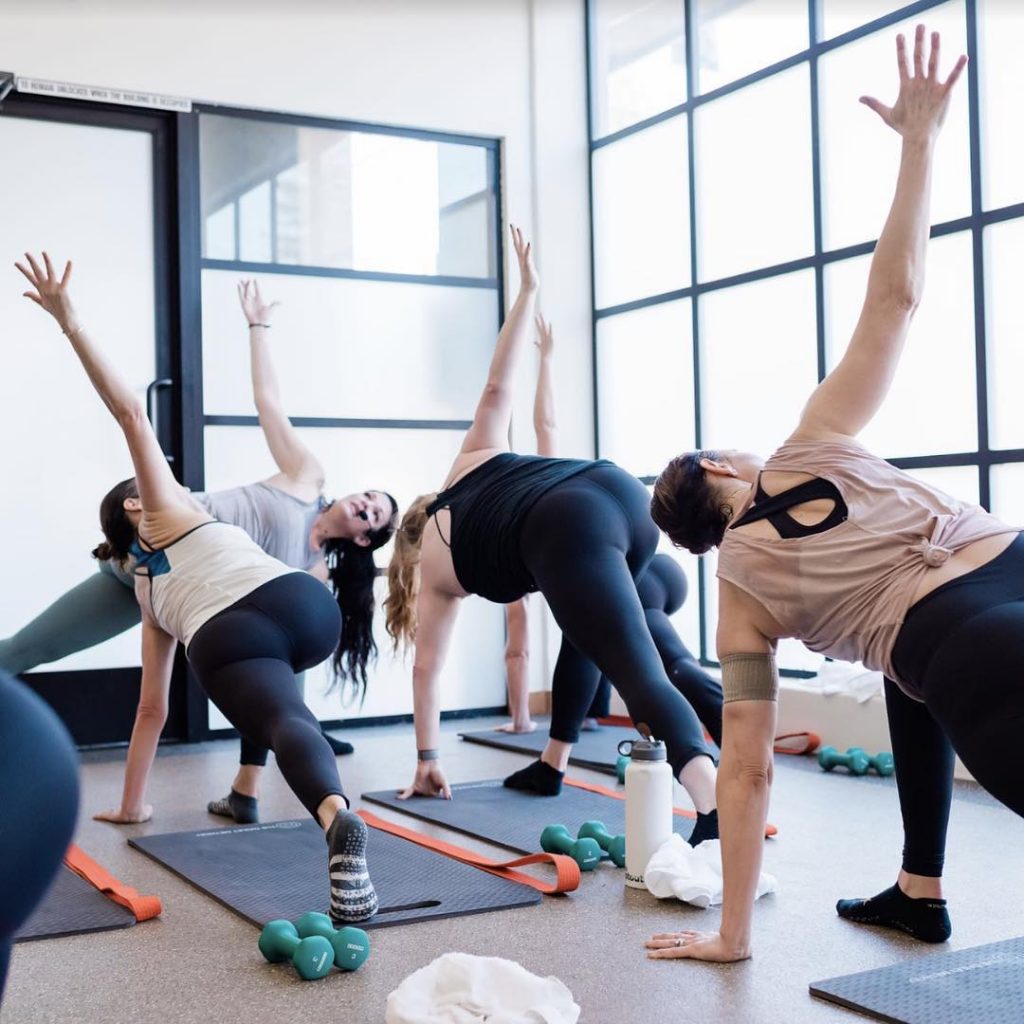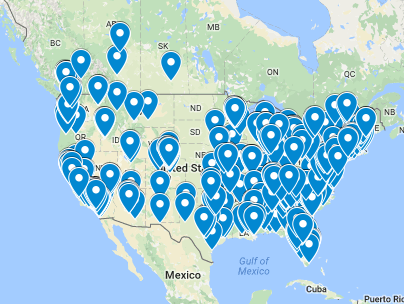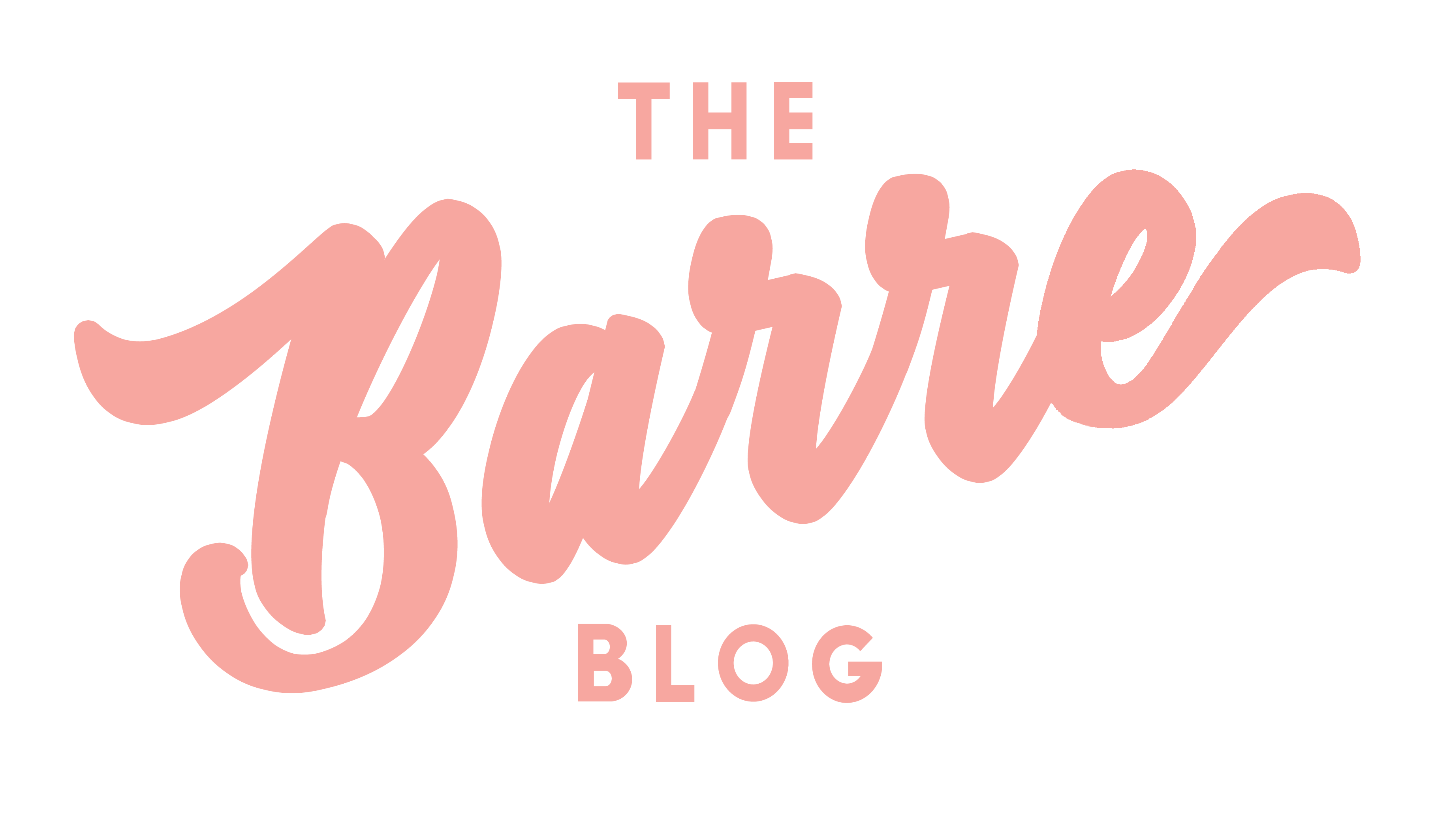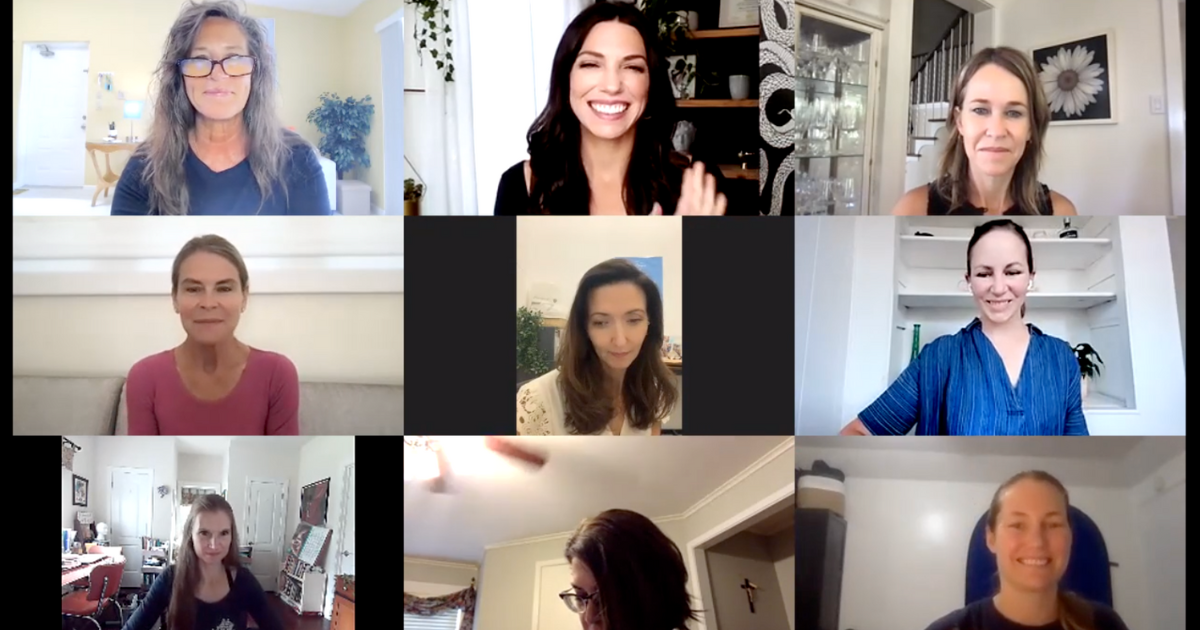
Pilates has the Pilates Method Alliance and yoga has the Yoga Alliance but up until now, there was no comparable alliance for the barre industry. Introducing the Barre Fitness Alliance.
Since barre went mainstream, anyone using a ballet barre as a prop was describing it as a “barre” class, although methods and choreography could be markedly different from one class to another. There was no oversight committee in the barre industry so anyone could put a certification course together and charge money to “certify” instructors.
It seemed fitting that someone or a collective group of people needed to come along and identify what barre is and isn’t and offer some oversight.
It has been a long time coming, according to BFA President, Lara Foldvari of Barre On the Go (formerly The Bog – Barre Over Garage.) She is joined by some industry heavyweights including Andrea Isabelle Lucas, Founder & CEO of Barre & Soul, Jennifer Maanavi, CEO and co-founder of Physique 57, Betsy Royster, co-owner of Bayou Barre and Jill Dailey, Founder of The Dailey Method. They are supported by barre pioneers Elisabeth Halfpapp and Fred DeVito of Core Barre Fit and also formerly of the Lotte Berk Method and Exhale.
In a nutshell, what is the Barre Fitness Alliance?
The BFA was hatched from a desire to assign a richer standard to barre certifications, classes and instructors.
“Our mission is to bring barre professionals together without bias to any one particular barre training,” says Lara. “We want to uphold the history of Lotte Berk both the human and the Lotte Berk Method studio in New York City and we want to ensure the quality of today’s instructors and really the integrity of the industry now and into the future. We want to ensure barre going forward remains not watered down for years to come.”
If you’re a barre teacher training organization, barre studio, instructor or even an enthusiast, the alliance is meant to be a resource for you.
What does the Barre Fitness Alliance consider to be the gold standard of barre?
If you’re familiar with the rich history of barre, then you know that there was Lotte Berk who famously invented the first iteration of what we know as barre today, and then everything that evolved from her original technique since. Considering barre fitness classes today are wildly different from what Lotte originally taught, there are actually two standards that the BFA uses as their bellwether. They are the teachings that came from the now-shuttered Lotte Berk Method in New York City, and Lotte Berk’s original technique as taught to Esther Fairfax her daughter and subsequently other trainees that carry on her legacy today like Long Beach’s theLONDONmethod.
“We’ve set the barre industry standards going back to the Lotte Berk Method in New York City for our members to uphold. Through these measures, the quality of barre instruction is maintained, which benefits those in our industry and the communities we serve,” says Lara.
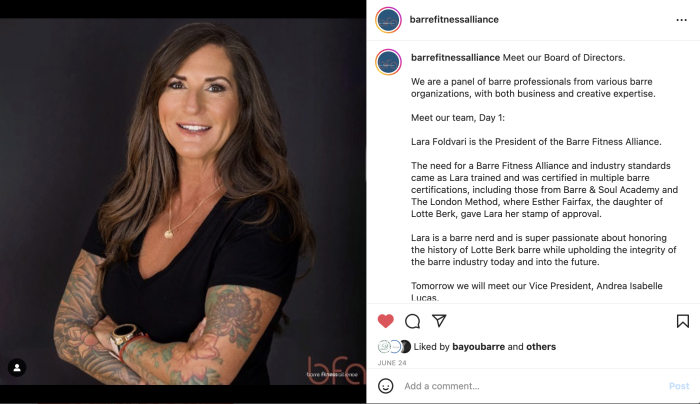
A Barre Fitness Alliance Instagram post featuring Lara Foldvari, President of the BFA
What you receive when you become a member.
- Members receive access to partner discounts on everything from retail to fitness equipment, certifications, apparel, AV equipment, liability insurance and more.
- If you become a BFA-certified instructor, studio or training program, you can display the corresponding virtual badge on your website for everyone to see.
- Anyone who visits the BFA website will be able to identify you in the public-facing directory.
- You will be able to network with other highly qualified instructors through virtual and in-person workshops and events.
- You will have a voice on what future industry standards should look like.
What you’ll get as a founding member.
All of the partner programs offer 20% off their training. There will be more opportunities for continuing education among partner certifications.
Pointe Studio offers product discounts. Vita Barre offers discounts on barres and other fitness equipment. AV Now offers discounts on audio-visual equipment.
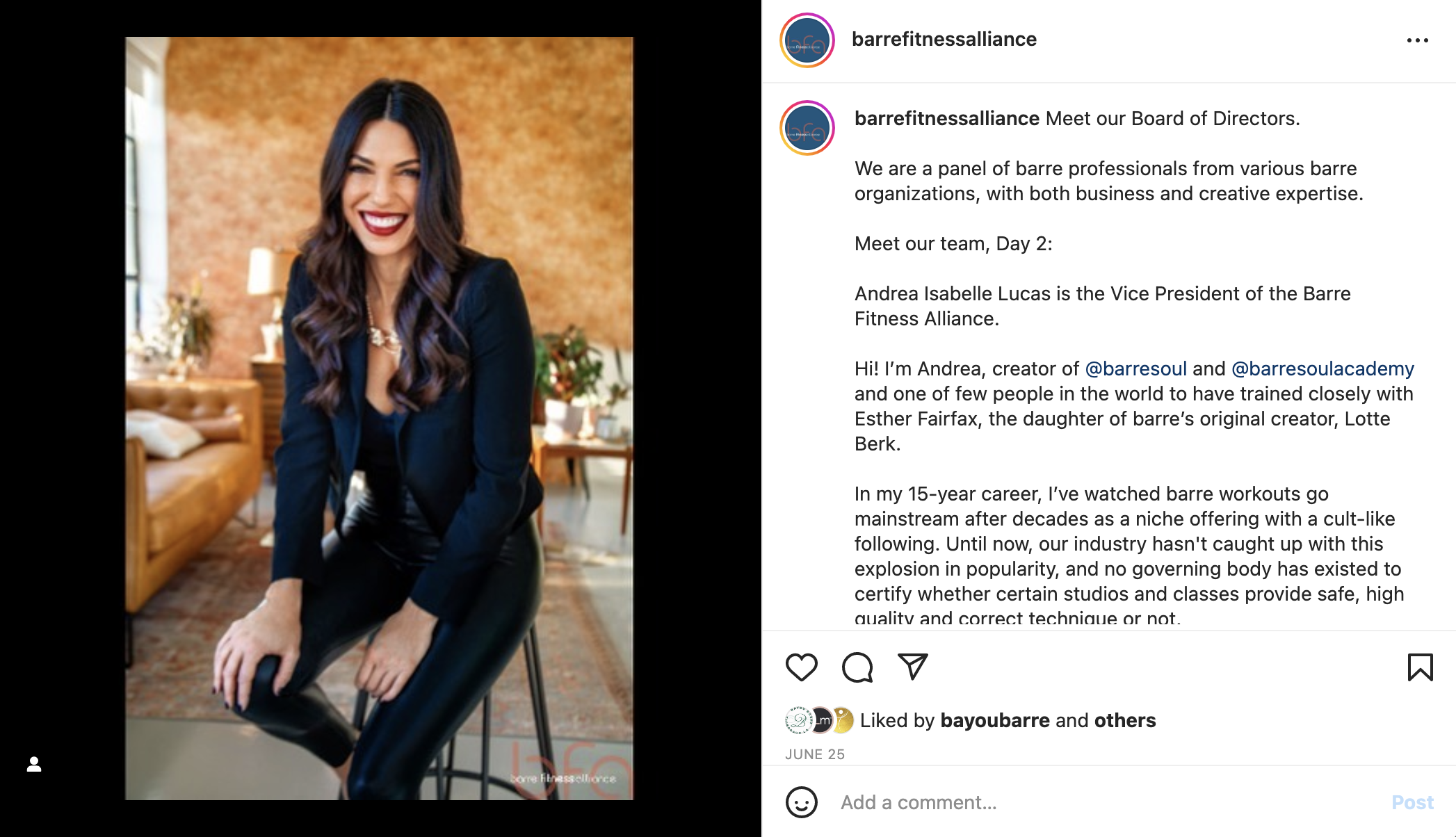
An Instagram post from the Barre Fitness Alliance introducing Andrea Isabelle Lucas, VP of the BFA
How to apply to be a founding member.
You can apply on the website. To become a BFA-approved instructor, there is a one-time processing and registration fee of $140. An annual membership (at the time of writing) in subsequent years will cost you $130. To become a BFA-approved teacher training organization, membership and processing fees for the first year cost $599 and the limited founding teacher training organization rate is $549 for the first year.
If you have any questions, send an email to barrefitnessalliance@gmail.com or a direct Instagram message to instagram.com/barrefitnessalliance.
What are the requirements for a certification to become accepted by the BFA?
Certifications must be a minimum of 100 hours in training and cover:
- The history of barre
- Anatomy
- Exercise science
- Musicality
- How to put a class together
- Modifications/variations
- Hands-on adjustments
- Practice teaching
- A written and practical exam
- 25 of the 28 exercises listed in the syllabus criteria.
You can see the full breakdown here.
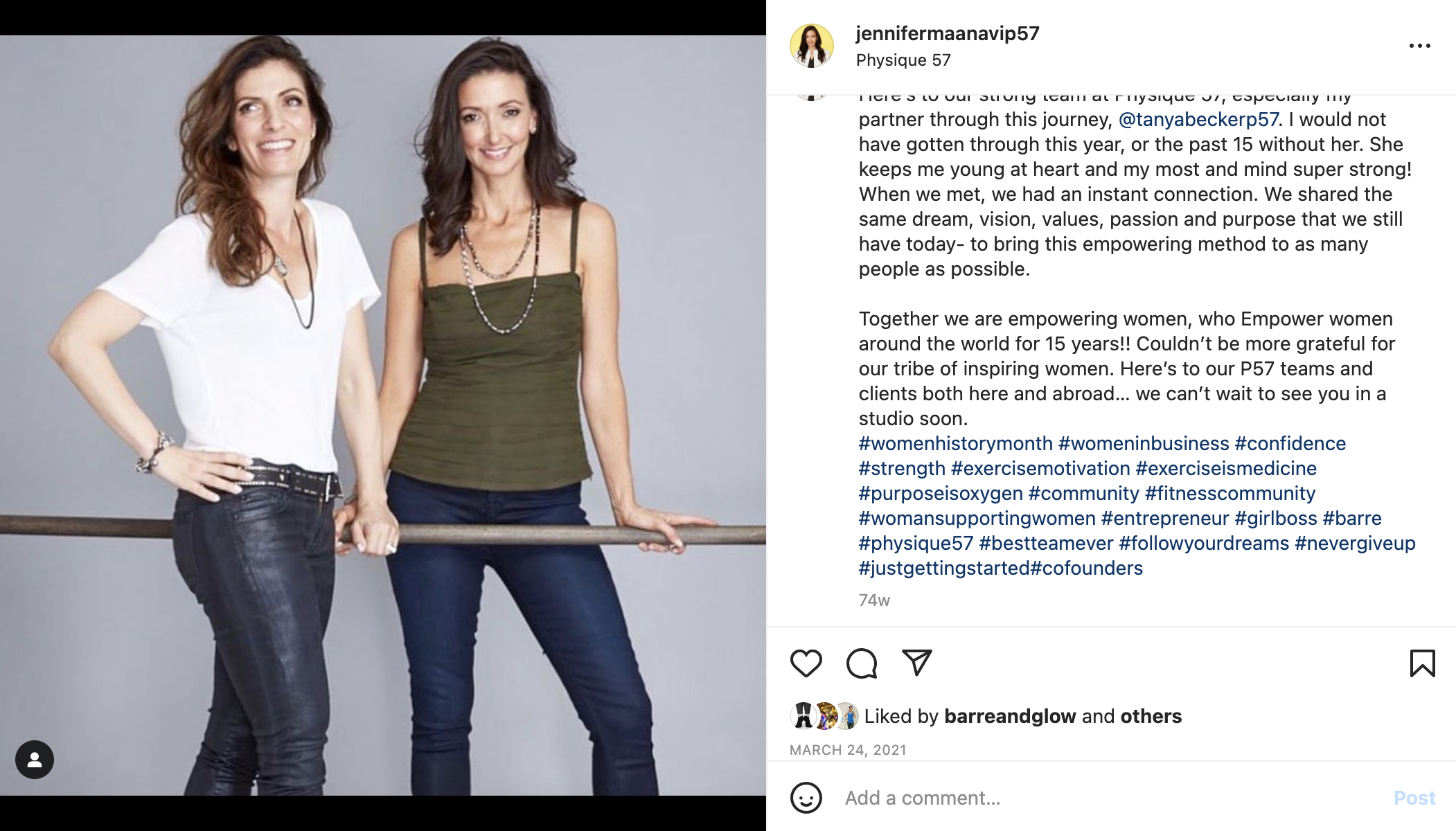
A post from Jennifer Maanavi’s Instagram, Treasurer of the BFA
What you receive when you become a BFA-certified teacher training organization.
- You’ll be able to display the BFA barre teacher-training badge on your website and be listed as an approved teacher training organization in the BFA directory.
- You will have a voice in future industry standard discussions.
- You’ll be able to offer discounts on training to other members.
Will in-house training programs from franchises like Pure Barre, The Bar Method or Barre3 be recognized?
Any certification program whether it is public-facing or not is invited to submit an application for review. Barre3, one of the world’s largest and most popular barre franchises for example auditions instructors before they go through their in-house training.
In order for a certification to be properly vetted by the board, the company hosting the training needs to provide a syllabus and training materials for review. Since some franchises are known to keep their training materials close to their chest it is yet to be seen if any of the franchises will be willing to disclose (at least to the board) their proprietary information.
If you’ve been trained through a franchise that isn’t already a BFA education partner, the BFA encourages you to speak with your managers or write to the heads of the company where you were trained to see if they would be interested in applying.
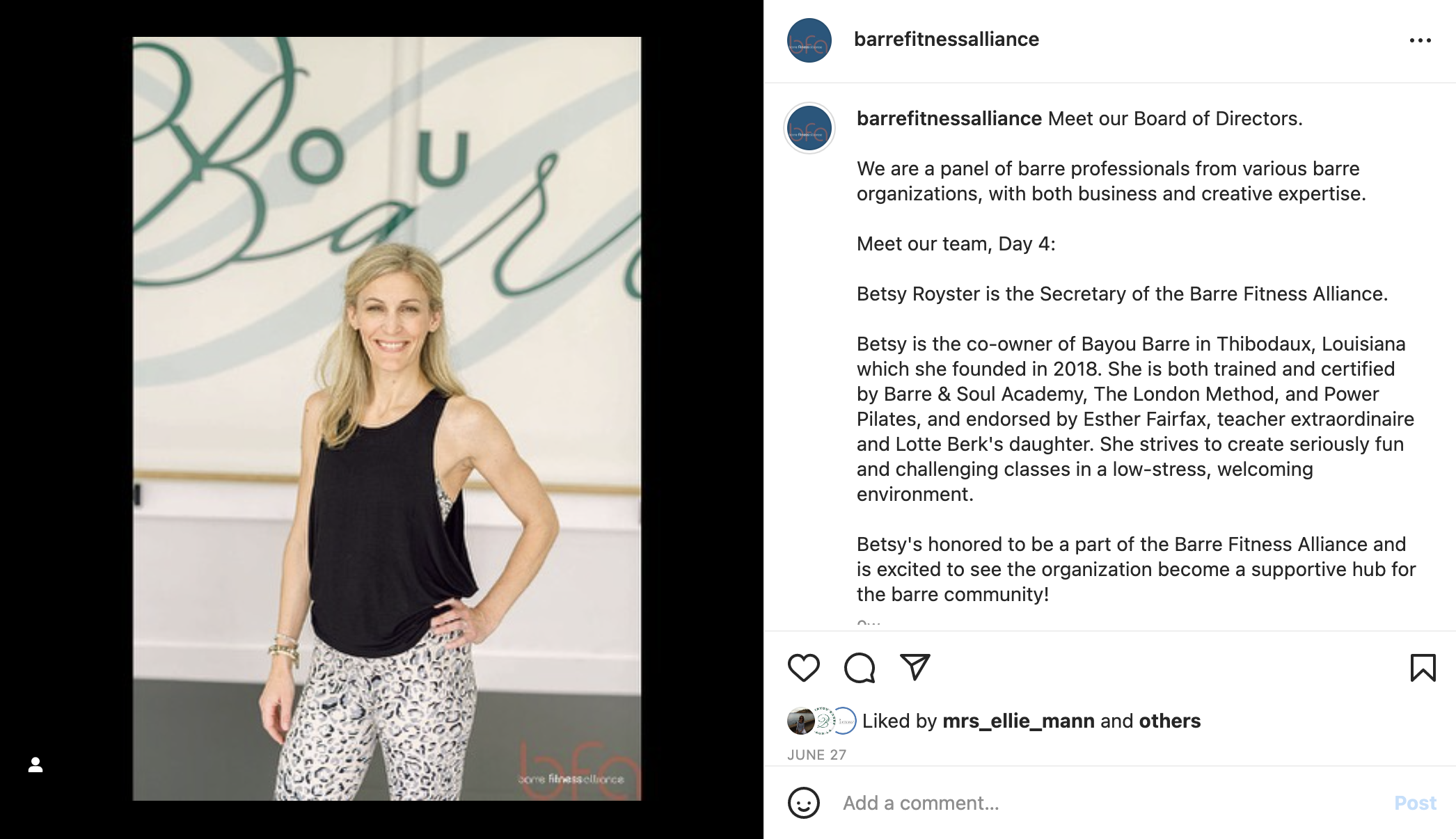
BFA Secretary and Bayou Barre’s Betsy Royster is introduced on the Barre Fitness Alliance’s Instagram account.
What are the requirements to become a BFA-certified studio?
To become a BFA-certified studio, you will need at least two of your instructors to be certified by a BFA-approved Barre Teacher Training Program. If not instructors, then a Director, Owner, Master Trainer or Manager of the studio. Also at least one of those instructors needs to be BFA approved, so they need to show proof of certification in the year they applied and with yearly renewals.
Is it necessary to join the Barre Fitness Alliance?
Like any exercise discipline with a professional association, you are not forced to join it in order to run classes. It all depends on what you’re looking to get out of becoming a barre teacher, opening a studio or offering a certification program. If you’re looking to build credibility among your clientele and peers, joining the alliance is a good way of establishing that.
If you’re a fitness instructor, having a BFA-approved certification behind your name can be an easy way to fast-track job offers, especially when busy studio owners don’t want to spend more time than they need trying to assess your skill level.
Both the Pilates Method Alliance and the Yoga Alliance weren’t built overnight. It will take time for the credibility of the BFA to grow and not everyone in the industry will be on board with this particular group of people deciding what should and should not count as barre. In my opinion, this is a remarkable who’s who of the industry. You have some of the most sought-after owners, teachers and business people on the board, and I believe they know what they’re talking about.
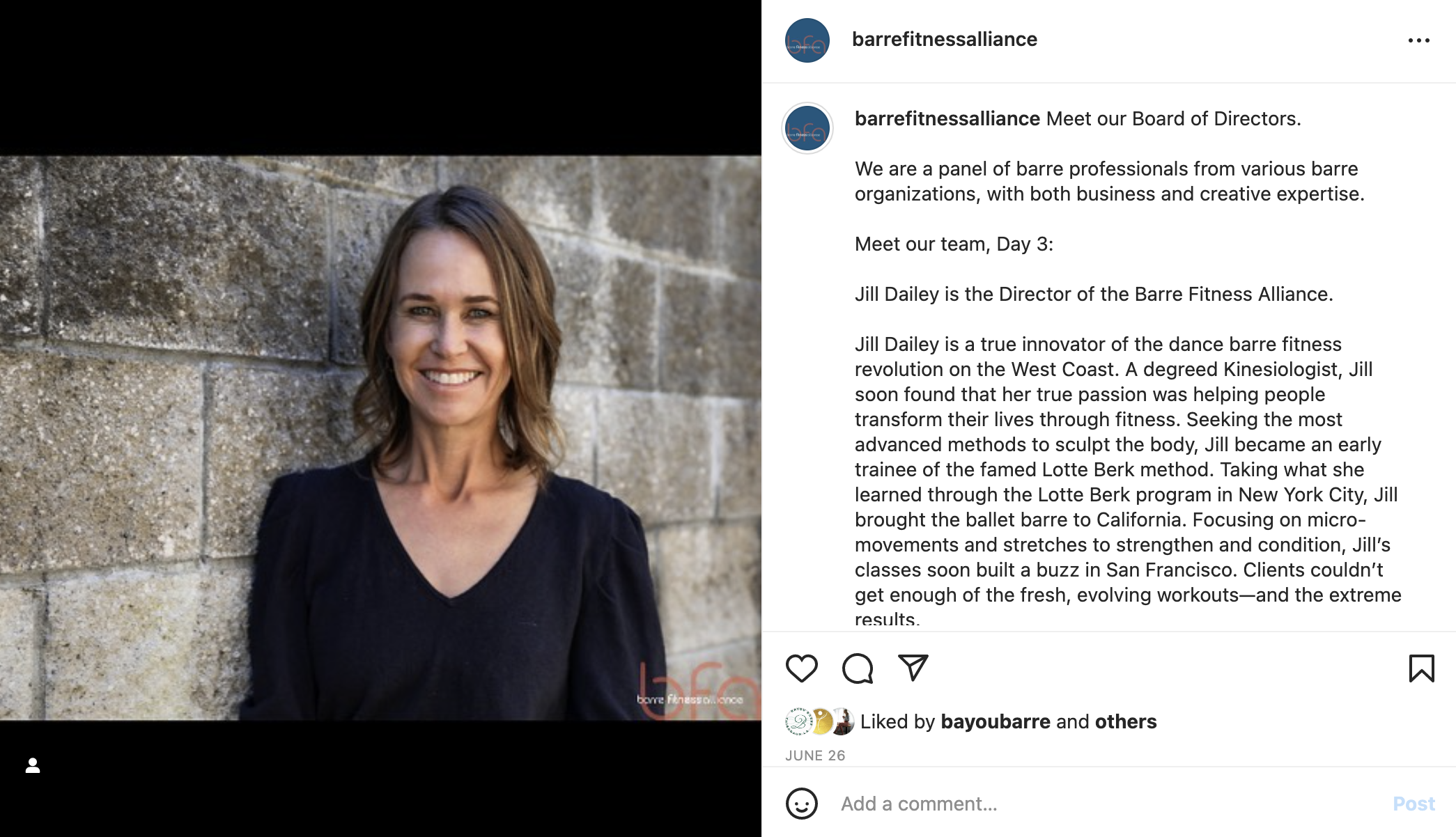
The Dailey Method’s Jill Dailey is introduced as BFA Director on their Instagram.
What does the future of the BFA look like?
In a Zoom call with members back in early August, the board of directors was pressed on whether certification criteria might evolve in the future to reflect the changing barre landscape. In response to that question, BFA Vice President Andrea Isabelle Lucas had this to say. “Yeah absolutely. We should all admit that we’ve all evolved the method. It will be a challenging and really productive exercise for us to start to evaluate more trainings that are maybe a little bit less similar.”
When speaking with Lara Foldvari in a separate follow-up call she seemed optimistic yet realistic about what the future could hold. She has hopes of growing the BFA base to rival industry counterparts like the yoga and Pilates alliances, while also knowing that the Yoga Alliance has 100,000 certified instructors in their base and barre does not have as much mainstream influence as yoga or Pilates. “We know how barre has evolved, we anticipate barre industry standards to evolve and grow as we do,” says Lara.
The BFA plans to host a mixture of in-person and virtual events throughout the year with the hopes of hosting at least one in-person event annually. I for one can’t wait to see what’s in store for the alliance and all involved.
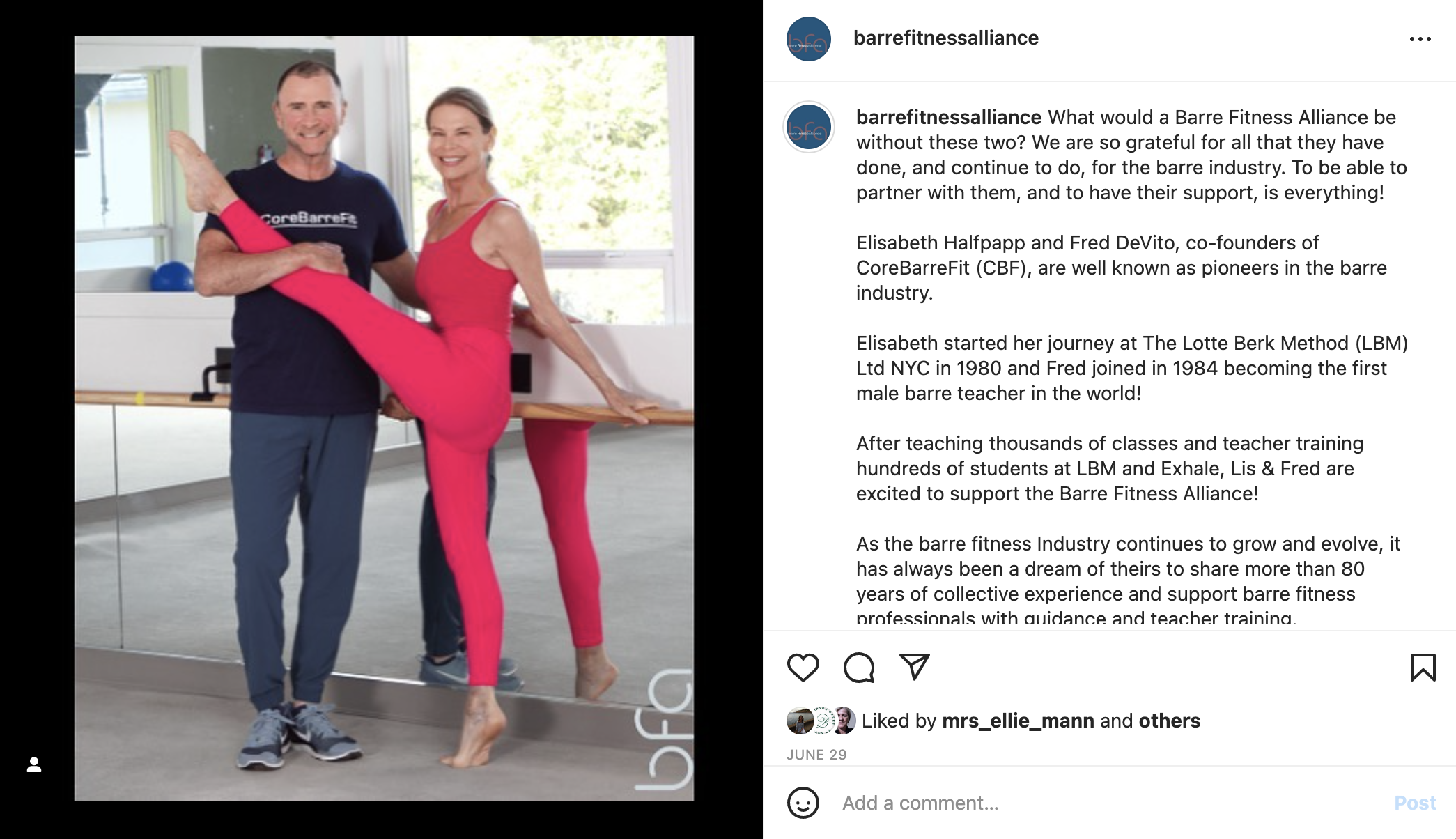
Elisabeth Halfpapp and Fred DeVito of Core Barre Fit are Supporting Partners of the BFA.


